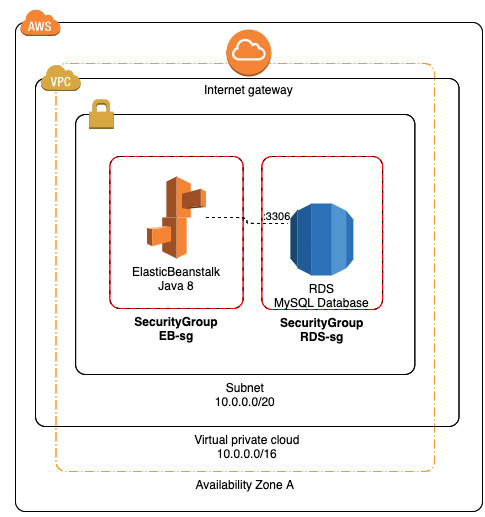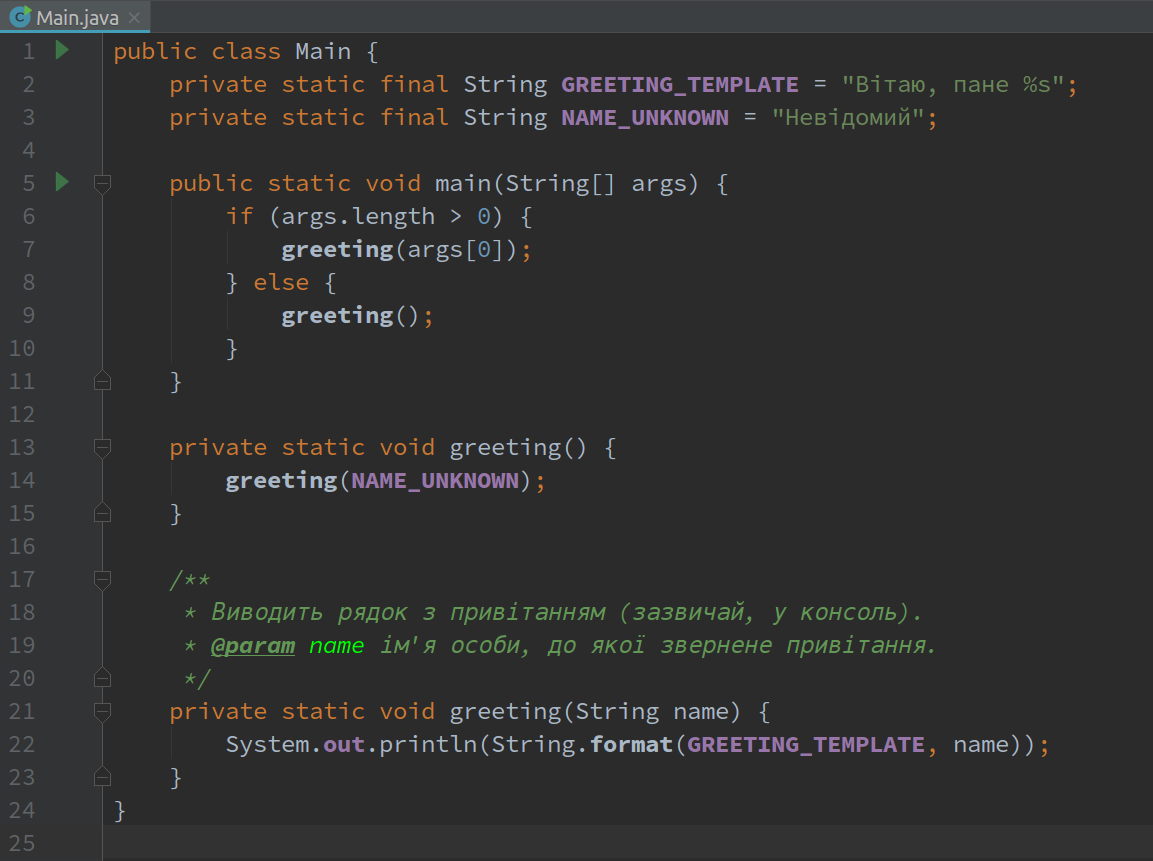8 min to read
Bootstrap complete Java application infrastructure in AWS with Terraform
How to bootstrap a Java + MySql application infrastructure with terraform

Terraform provides a way of describe infrastructure as code. Terraform will manage the communication with the infrastructure provider (Amazon AWS in this example) to create, update or delete infrastructure resources.
Bootstrap ElasticBeanstalk + RDS MySql application
In the following example we are going to bootstrap the necessary infrastructure to serve a Java API connected to RDS MySql database.

Step 1 - Networking
We are going to create a terraform module for VPC and other networking resources:
- VPC - Virtual Private Cloud: Is a logical group of resources that are isolated from other VPCs and other customers of the Public Cloud.
- VPC Subnet : A VPC Subnet is defined by a subrange of the network IP addresses assigned to the VPC.
- Security Group : The VPC Security Groups are the way AWS implements firewalls between instances in the VPC. In a VPC all inbound and outbound network traffic is denied by default. In order to allow traffic, a security group is defined and rules are assigned to the Security Group.
The following is a terraform module to group all the needed networking resources in just one file.
resource "aws_vpc" "_" {
cidr_block = var.vpc_cidr
enable_dns_support = var.enable_dns_support
enable_dns_hostnames = var.enable_dns_hostnames
tags = {
Name = "${var.app-name}-vpc"
}
}
resource "aws_internet_gateway" "gateway" {
vpc_id = aws_vpc._.id
tags = {
Name = "${var.app-name}-gateway"
}
}
resource "aws_route_table" "route_table" {
vpc_id = aws_vpc._.id
dynamic "route" {
for_each = var.routes
content {
cidr_block = route.value.cidr_block
gateway_id = aws_internet_gateway.gateway.id
instance_id = route.value.instance_id
nat_gateway_id = route.value.nat_gateway_id
}
}
tags = {
Name = "${var.app-name}-route-table"
}
}
resource "aws_subnet" "subnet-a" {
vpc_id = aws_vpc._.id
cidr_block = "10.0.32.0/20"
availability_zone = "${var.region}a"
map_public_ip_on_launch = true
tags = {
Name = "${var.app-name}-subnet-a"
}
}
output "_" {
value = {
vpc_id = aws_vpc._.id
subnet_a = aws_subnet.subnet-a.id
}
}
Step 2 - RDS MySql database
Now we need to define the RDS Database with the corresponding security group, note that RDS security group has a reference to another security group, this will allow ingress traffic from elastic beanstalk instance to the database.
resource "aws_security_group" "rds-sg" {
name = "rds-sg"
description = "RDS (terraform-managed)"
vpc_id = module.vpc._.vpc_id
# Only MySQL port in for elastic beanstalk instance
ingress {
from_port = var.rds-port
to_port = var.rds-port
protocol = "tcp"
security_groups = [aws_security_group.eb-sg.id]
}
# Allow all outbound traffic.
egress {
from_port = 0
to_port = 0
protocol = "-1"
cidr_blocks = ["0.0.0.0/0"]
}
tags = {
Name = "RDS_sg"
}
}
resource "aws_db_instance" "rds-db" {
name = var.rds-schema
identifier = var.rds-identifier
allocated_storage = 20
backup_retention_period = 7
backup_window = "10:46-11:16"
maintenance_window = "Mon:00:00-Mon:03:00"
engine = "mysql"
engine_version = "8.0.15"
instance_class = "db.t2.micro"
username = var.rds-username
password = var.rds-password
port = var.rds-port
publicly_accessible = true
storage_type = "gp2"
allow_major_version_upgrade = false
auto_minor_version_upgrade = true
performance_insights_enabled = false
skip_final_snapshot = true
final_snapshot_identifier = "database-${var.rds-schema}-snapshot"
vpc_security_group_ids = [aws_security_group.rds-sg.id]
availability_zone = var.rds-availability_zone
multi_az = var.rds-multi_az
}
Step 3 - Elastic Beanstalk
Elastic Beanstalk is a great way to deploy Java applications, you only need to focus on the application. The service can be configured as a single instance or load balanced. In this example we are going to deploy single instance, but for production applications is highly recommended configuring as load balanced with a minimum of 2 instances, is not only about performance, with this configuration when you deploy a new version AWS will replace 1 instance at the time and wait to be in healthy state, this way we can achieve 0 downtime.
resource "aws_security_group" "eb-sg" {
name = "eb-sg"
description = "SecurityGroup for ElasticBeanstalk environment."
vpc_id = module.vpc._.vpc_id
ingress {
from_port = 80
to_port = 80
protocol = "tcp"
cidr_blocks = ["0.0.0.0/0"]
ipv6_cidr_blocks = ["::/0"]
}
ingress {
from_port = 587
to_port = 587
protocol = "tcp"
cidr_blocks = ["0.0.0.0/0"]
ipv6_cidr_blocks = ["::/0"]
}
egress {
from_port = 0
to_port = 0
protocol = "-1"
cidr_blocks = ["0.0.0.0/0"]
}
tags = {
Name = "EB_sg"
}
}
# ElasticBeanstalk - Application
resource "aws_elastic_beanstalk_application" "eb-application" {
name = var.app-name
depends_on = [aws_db_instance.rds-db]
}
# ElasticBeanstalk - Environment
resource "aws_elastic_beanstalk_environment" "eb-env-prod" {
depends_on = [aws_db_instance.rds-db]
name = "${var.app-name}-prod"
application = aws_elastic_beanstalk_application.eb-application.name
solution_stack_name = data.aws_elastic_beanstalk_solution_stack.java8.name
cname_prefix = var.app-name
setting {
namespace = "aws:autoscaling:launchconfiguration"
name = "InstanceType"
value = "t2.micro"
}
setting {
namespace = "aws:elasticbeanstalk:environment"
name = "EnvironmentType"
value = "SingleInstance"
}
setting {
namespace = "aws:autoscaling:launchconfiguration"
name = "IamInstanceProfile"
value = "aws-elasticbeanstalk-ec2-role"
}
setting {
namespace = "aws:autoscaling:launchconfiguration"
name = "InstanceType"
value = "t2.micro"
}
setting {
namespace = "aws:elasticbeanstalk:application:environment"
name = "SPRING_PROFILES_ACTIVE"
value = "prod"
}
setting {
namespace = "aws:elasticbeanstalk:application:environment"
name = "SPRING_DATASOURCE_URL"
value = "jdbc:mysql://${aws_db_instance.rds-db.endpoint}/${aws_db_instance.rds-db.name}?useSSL=false"
}
setting {
namespace = "aws:elasticbeanstalk:application:environment"
name = "SPRING_DATASOURCE_USERNAME"
value = aws_db_instance.rds-db.username
}
setting {
namespace = "aws:elasticbeanstalk:application:environment"
name = "SPRING_DATASOURCE_PASSWORD"
value = aws_db_instance.rds-db.password
}
setting {
namespace = "aws:autoscaling:launchconfiguration"
name = "SecurityGroups"
value = aws_security_group.eb-sg.id
}
setting {
namespace = "aws:ec2:vpc"
name = "VPCId"
value = module.vpc._.vpc_id
}
setting {
namespace = "aws:ec2:vpc"
name = "Subnets"
value = module.vpc._.subnet_a
}
setting {
namespace = "aws:ec2:vpc"
name = "VPCId"
value = module.vpc._.vpc_id
}
setting {
namespace = "aws:ec2:vpc"
name = "AssociatePublicIpAddress"
value = "true"
}
}
Deploy infrastructure
With terraform, only we need to do is execute the following command, providing a file with all the variables we have defined
terraform apply -var-file="test.tfvars"
You can find the complete code of this example in this GitHub repository



